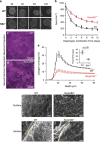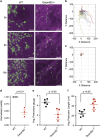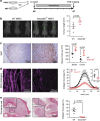SerpinB2 regulates stromal remodelling and local invasion in pancreatic cancer
- PMID: 28346421
- PMCID: PMC5537606
- DOI: 10.1038/onc.2017.63
SerpinB2 regulates stromal remodelling and local invasion in pancreatic cancer
Abstract
Pancreatic cancer has a devastating prognosis, with an overall 5-year survival rate of ~8%, restricted treatment options and characteristic molecular heterogeneity. SerpinB2 expression, particularly in the stromal compartment, is associated with reduced metastasis and prolonged survival in pancreatic ductal adenocarcinoma (PDAC) and our genomic analysis revealed that SERPINB2 is frequently deleted in PDAC. We show that SerpinB2 is required by stromal cells for normal collagen remodelling in vitro, regulating fibroblast interaction and engagement with collagen in the contracting matrix. In a pancreatic cancer allograft model, co-injection of PDAC cancer cells and SerpinB2-/- mouse embryonic fibroblasts (MEFs) resulted in increased tumour growth, aberrant remodelling of the extracellular matrix (ECM) and increased local invasion from the primary tumour. These tumours also displayed elevated proteolytic activity of the primary biochemical target of SerpinB2-urokinase plasminogen activator (uPA). In a large cohort of patients with resected PDAC, we show that increasing uPA mRNA expression was significantly associated with poorer survival following pancreatectomy. This study establishes a novel role for SerpinB2 in the stromal compartment in PDAC invasion through regulation of stromal remodelling and highlights the SerpinB2/uPA axis for further investigation as a potential therapeutic target in pancreatic cancer.
Conflict of interest statement
The authors declare no conflict of interest.
Figures






References
-
- Siegel RL, Miller KD, Jemal A. Cancer statistics, 2016. CA Cancer J Clin 2016; 66: 7–30. - PubMed
-
- Neesse A, Michl P, Frese KK, Feig C, Cook N, Jacobetz MA et al. Stromal biology and therapy in pancreatic cancer. Gut 2011; 60: 861–868. - PubMed
-
- Goldstein D, El-Maraghi RH, Hammel P, Heinemann V, Kunzmann V, Sastre J et al. nab-Paclitaxel plus gemcitabine for metastatic pancreatic cancer: long-term survival from a phase III trial. J Natl Cancer Inst 2015; 107: dju413. - PubMed
-
- Rowe RG, Sheikh R, Weiss SJ, Walsh N, Clynes M, O’Connor R et al. Challenges of drug resistance in the management of pancreatic cancer. Cancer Epidemiol Biomarkers Prevent 2000; 9: 1647–1661. - PubMed
Publication types
MeSH terms
Substances
LinkOut - more resources
Full Text Sources
Other Literature Sources
Medical
Miscellaneous

